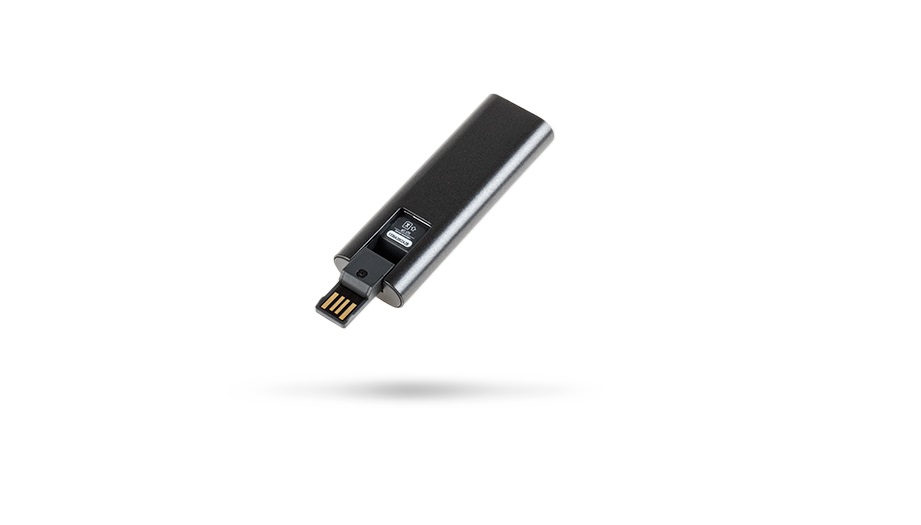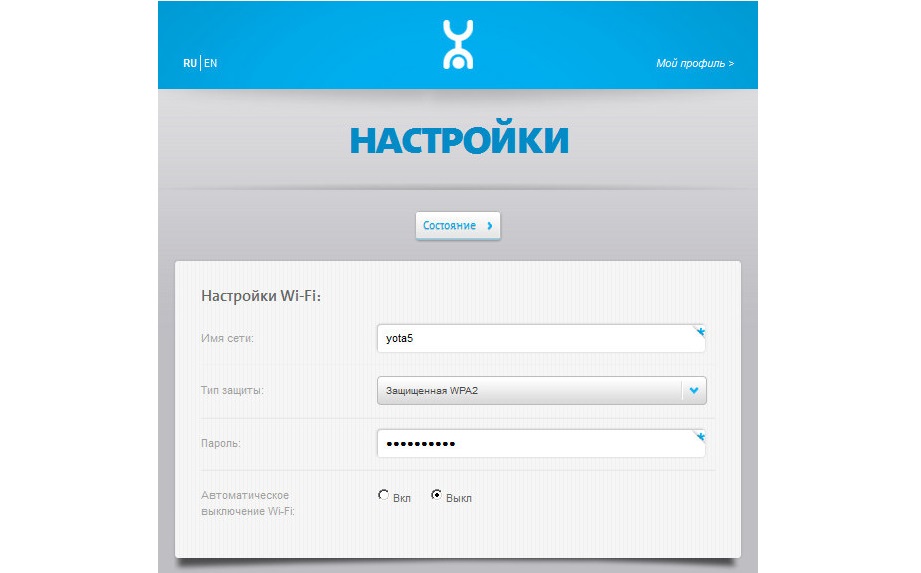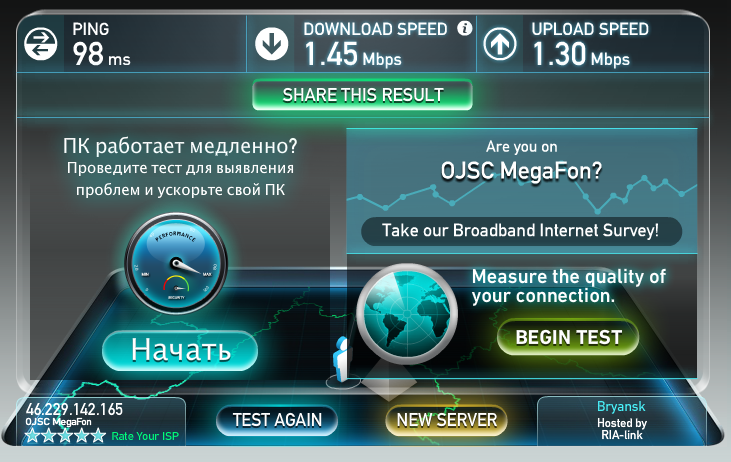Yota is a fairly young company on the market mobile communications and wireless Internet access. Due to the fact that the company does not stand still and is constantly improving, the number of its subscribers is rapidly increasing. The most significant moments in the company’s activities include the fact that Yota was the first in the world to launch LTE-Advanced mobile communication technology in Moscow. It is also worth noting that just a year ago Yota received the status of a federal operator cellular communications in Russia. Since these days it is gaining widespread popularity wireless access to the Internet using the 4G/4G+ network, then Yota did not stand aside and entered the fight for this segment of the communications market.
Review of popular Yota 4G modems
One of the areas the company focused on was the development of its own portable USB modems for laptops and desktop computers.
"Yota modem"
This representative of the Yota modem family is the simplest of its kind. The modem has a strict and laconic design. Its main advantage is a powerful built-in antenna, which not every device can boast of. An interestingly thought-out USB mechanism system that makes it easy to prepare the device for use. Some of the interesting features of this modem include:
In addition to the modem itself, the package also includes a SIM card. The price of such a kit is 950 rubles.
It is worth noting that all Yota modems are capable of working not only in the 4G network, but also in the 3G and 2G networks.
Advice from the site
"Wi-Fi Modem Yota"

This modem is an improved version of its counterpart discussed above with a wider range of capabilities and applications. If we talk about the design of the device, it is simple and extremely convenient and practically no different from the modem discussed earlier. Key Feature this instance is the possibility of using it not only as a modem, but also as Wi-Fi router A. As a Wi-Fi router, the device is capable of providing network access to up to 8 devices simultaneously. It is worth noting that the device itself can simply be connected to a power source via USB, and you will have access to 4G Internet on all devices that support Wi-Fi. Speaking about technical parameters, it should be said about the LTE operating frequency range of 2.5 - 2.7 GHz. As for the weight, it is only 50 grams. Some of the interesting features of this modem include:
With this modem, you do not need any driver installation for it to work.
The modem works great with almost any device that has a USB connector.
Ideal for: tablet, laptop and desktop computers.
4G Internet distribution at Wi-Fi assistance for simultaneous operation of up to 8 devices.
The device is capable of supporting such operating systems like Windows, Mac OS and Linux.
In addition to the modem itself, the package also includes a SIM card. The price of such a kit is 2900 rubles.
A rather interesting and thoughtful solution from Yota is the opportunity to get a modem for a free test drive, after which you can decide whether you need the device or not.
Advice from the site
Setting up a Yota 4G modem

Make sure the SIM card is inserted into the USB modem.
Plug the modem into an available USB port on your computer or laptop.
After the USB modem is connected, it should start automatic installation drivers software. Do not remove the modem from the port until complete installation drivers. If the device is installed remotely, you will have to have someone install it, as there is a high probability that it will not work correctly. Correct installation The driver will be symbolized by the inscription “Remote NDIS based Internet Sharing Device” is ready for use.
After registering in personal account and tariff plan settings, remove the modem and reinsert it, you may need to restart the computer system. After which you will be able to enjoy 4G Internet from Yota.
If you have any questions about certain settings, you can contact your operator for help by dialing from your mobile phone 88005500007 "call". You can also try to find the answer to your question on the Yota website in the section
Overall, good quality coverage. mobile internet in the village it is a sore subject for many users. It seems that this group of people needs 3G coverage the most, but our operators do not think so.
I’ll say right away that the action took place in one of the villages of the Klintsovsky district, Bryansk region. I took two SIM cards with me different operators- Beeline, which I use, and Yota, which is a new operator for me. In addition, there was already a SIM card from Megafon with their 3G modem - Huawei E173, which I unlocked.
Having been outside the normal leased line of 40 Mbit/s for several days, you immediately understand the “buzz” of the vaunted 3G Internet from these operators. But first things first. Let's start with Yota. Reviews about the operation of 3G/4G Internet from Yota are mostly negative, sometimes they cut the speed, sometimes they prohibit distributing traffic, sometimes they prohibit P2P (torrent), and so on. In general, they are still parasites.
Well, I had to see this for myself. I had a tariff for 240 rubles, giving full unlimited (OGA... we believed) 3G/4G. In the village Yota not only couldn’t get 3G, but he didn’t see regular EDGE. There was no signal at all. Although, when you look at Yota’s coverage in this area, everything is fine on the map, in reality, Yota was never able to pick up any signal.
outside the city and in remote areas, the connection speed is terrible, and the further you get from the city, the worse the Internet is.
Megafon showed itself stable, and the Internet was at the level of 1.5 Mb/s, but in the evening the average speed did not exceed 1 Mb/s, mobile Internet testing took place on a modem Huawei E173.
The pages loaded quite quickly, sometimes there were problems with the speed, which dropped to 300kb/s, but overall everything was quite good. There was no talk about watching video from a 3G modem, since it was simply impossible to normally watch video online from a modem.
The beeline with the Internet in the Klintsovsky district of the Bryansk region turned out to be much worse than I expected. Upon arrival, I was immediately warned to forget about using SIM cards Beeline, since they “don’t catch here at all.”
But, remembering how in 2011 I received a speed of 2-3 Mb/s on a Beeline, I wanted to get the same speed in 2015. But four years have passed and everything has only gotten worse. The average speed of 0.5-1Mb/s and constant connection interruptions have become a serious obstacle to using the Internet.

Tin cans and a modem on the window did not save the situation. There was no talk of the former two megabits, although the ping turned out to be better compared to Megafon. In tests, the megaphone turned out to be head and shoulders above the beeline, although it did not show satisfactory Internet signal quality.
I have already sent a letter to Beeline with a request to increase throughput their channel in the Klintsovsky district to make it more convenient for people to use the Internet. But, knowing the country in which we live, most likely my letter will remain without a clear answer.
As for the megaphone, they are great. Yes, they show a speed of 1.5 megabits, but (!) this is the only operator that works more or less stably. It is unclear where other operators (in particular Yota) are looking.
Ilya Rubtsov,
Yota for many years remained only a fast food operator wireless internet, first in one standard, and then in another. So starting voice calls and turning into normal mobile operator– a significant event for the company. We studied how you can connect, what tariffs are offered, where there is coverage and whether it is worth it for Yota subscribers to travel abroad.
It’s worth admitting right away that there is a slight lie in the headline, as well as in Yota’s press releases. First, let “Iota” be a virtual operator. There is Scartel (a company operating under the Yota brand) and there is Megafon. The first has long been completely owned by the second. The technical infrastructure of both merged into a whole: MegaFon received an LTE network from Iota, and itself gave it 2G/3G for voice calls. De jure, the operators are different - each has its own legal entity. De facto, Yota can be considered a virtual operator on the MegaFon network (or vice versa, but MegaFon is more impressive, we will consider it the main one).
Secondly, the operator turned out to be not completely federal - Crimea fell out of the “all-Russian” coverage, and for some reason Taimyr and Norilsk have their own Internet tariffs.
Yota positions itself as an operator for modern people who are constantly online. You can say: “an operator for the iPhone” (more on the bitter irony here below).
What is the price?
Yota takes a simple approach to pricing without a ton of pricing plans. A distinctive feature of the operator’s tariffs has been preserved - a “slider” that allows you to configure the volume of the main service. Previously, when Yota sold only the Internet, it was speed (with invariably unlimited traffic), you can now select the number of call minutes.
But first things first. The minimum package in Moscow costs 440 rubles per month. It includes an unlimited number of calls within the network throughout Russia (no matter where the subscriber and the person he is calling are located) and 100 minutes of calls to numbers of other operators. SMS - 2.5 rubles per piece or 50 rubles for everything per month.
100 minutes is the smallest package; there are five of them to choose from; the maximum includes 20 hours of conversations with “strangers” for 1,590 rubles per month.
When moving to another region, you will need to choose a local package, otherwise you will be connected to the “Basic” tariff without Internet and with an inhumane per-minute calling rate of 2.5 rubles per minute. This happens after a month of non-stop living in a new place.
There is a nuance: if you settle in a place where Yota does not yet distribute SIM cards, then the “Regional” tariff will be activated - there is no Internet there either, and calls and SMS cost 3.5 rubles each.
Where does he work?
As I already said, Yota and Megafon actually merged their networks. This is how Megafon received a 4G network. So Yota received a 2G/3G network with support for voice calls. The coverage maps of both operators are the same with a few exceptions: Megafon does not share its own 4G coverage with Yota, which is modest, but still available in some cities.
Since the legal issue with VoLTE has not yet been resolved, Yota uses the CSFB mechanism - when making a call, the device is transferred from 4G mode to 2G or 3G mode. Sometimes this happens for quite a long time. And, of course, there will be an embarrassment if there is no Megafon network in this particular place.
Yota operates throughout the country. Not everywhere has 4G, but almost everywhere has 2G/3G. But the promised tariffs do not apply in all regions. Firstly, in Taimyr and Norilsk, instead of unlimited internet they slip in a measly 300 MB per month, and when they run out, the speed is cut to 64 Kbps. Which means that 90% of sites simply will not open due to a timeout. Secondly, Crimea for “Iota” is not Russia, others operate there - high ones! - tariffs for calls and Internet.
How to connect?
You can connect to Iota in only one way: by downloading mobile app for iOS or Android and through it by submitting an application for SIM card delivery. Version for Windows Phone only in plans for now. They deliver the card and a package of documents quite quickly, within a few days.
In the same application, you can then monitor the remaining minutes and messages or change tariff plan. And through the application it is proposed to communicate with the support service. After some time in the program you will be able to choose a beautiful number for yourself or buy an arbitrary one. However, so far all the numbers distributed to new subscribers are quite beautiful.
Despite the fact that Yota professes simplicity and minimalism, the company did not manage to agree with Apple and Google on many things, which significantly complicated the life of its subscribers. On both Android smartphones and iPhones, you will have to manually enter the APN in the settings to access the Internet.
Moreover, Apple has not yet given its blessing to the use of 4G mode in the Iota network, so at least until the fall, a special set of settings will not come to iPhones that allow connection to the LTE network. Yabloko will have to be content with “slow” 3G.
How much does roaming cost?
For roaming, Yota does not offer any tariff options, there are only basic prices. In Europe, for example, local outgoing calls and calls to your home country will cost 19 rubles per minute, incoming calls and sending SMS - 9 rubles. But the Internet is quite expensive - 90 rubles per megabyte. I tried to collect prices in other regions in a table:
|
Outgoing calls to Russia or host country, minute |
Outgoing calls to other countries, minute |
Incoming calls, minute |
Outgoing SMS, message |
Internet, 100 KB |
|
|
Popular countries * |
|||||
|
Satellite systems |
* Popular countries: Vietnam, Hong Kong, Egypt, Israel, China, Korea, UAE, USA, Puerto Rico, US Virgin Islands, Thailand, Japan
What can't be done?
Yota has long had a business providing fast mobile Internet for modems, so it had to be protected from new tariffs by artificial restrictions. The new tariffs can be used on smartphones and only on them. Laptops, desktop computers, modems and even tablets are illegal; for them the speed will be cut to an indecent 64 Kbps. The company could not clarify how they would deal with phablets - very large smartphones.
Enabling an access point in the device to distribute the Internet is also a crime by Yota standards, although not so terrible. For this, the speed is cut to 1 Mbit/s, you can live. The company probably decided to make such a compromise after receiving strong streams of hatred and misunderstanding this spring, when it first spoke about the planned conditions and, in particular, a complete ban on the distribution of the Internet.
Finally, torrents. If you download files from peer-to-peer networks, then you are an enemy of Yota, and your speed will be reduced to 64 Kbps. Hello fans of Blizzard games.
Should I take it?
Yota will not provide new network quality or new coverage. In this regard, the company’s capabilities completely coincide with Megafon’s offer. Yota is a tariff experiment and an attempt to make new model communication between the subscriber and the operator.
In an attempt to really unlimited services, the company had to follow the Western path and set the rules of the game. You cannot do whatever you want with the purchased Internet. It is only for smartphones. This behavior is new to Russian users. But now, knowing all the features of Iota, you can evaluate whether its fake “real unlimited” is suitable for you. You should hurry, because free beautiful numbers in the new dialing code 999 will soon run out.
